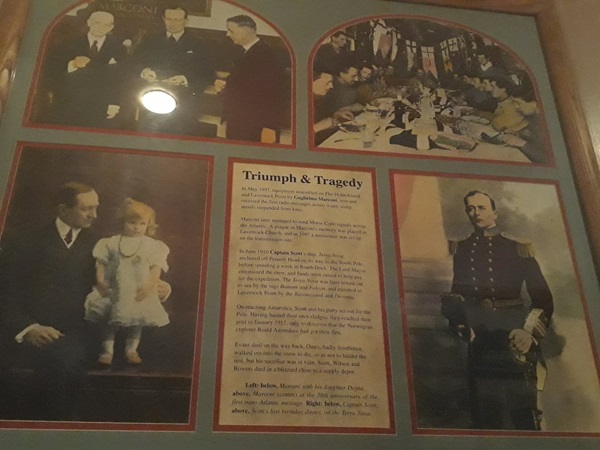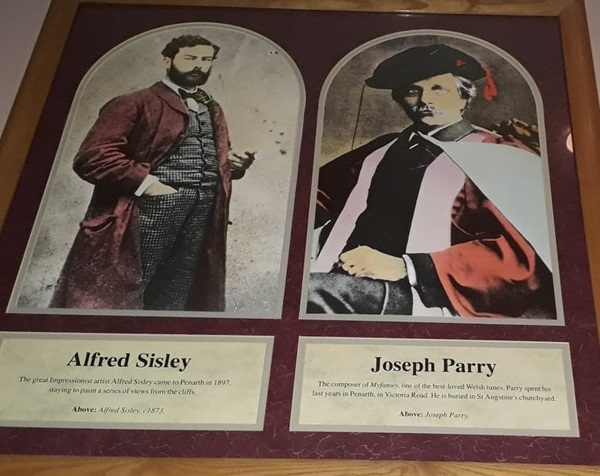This pub takes its name from the literal translation of Penarth (‘arth’ is ‘bear’; ‘pen’ is ‘head’). Around 150 years ago, Penarth comprised a few whitewashed cottages and farmhouses, its population 105. After the 1865 opening of the dock and the railway’s arrival, Penarth was never the same again. Much of the early planning in Penarth was the responsibility of Robert Forrest, who was in charge of the Glamorgan part of the Windsor estates – the owners of much of the land in Penarth.
Text about The Bear’s Head.

The text reads: Around 150 years ago Penarth consisted of a few whitewashed cottages and farmhouses, with a population of 105 people. After the opening of the Dock in 1865 and the arrival of the railway, Penarth was never the same again. Much of the early planning in Penarth was the responsibility of Robert Forrest, who was in charge of the Glamorgan part of the Windsor estates – the owners of much of the land in Penarth.
In 1875 the estate helped establish the ‘Local Board’, which administered three parishes including Penarth. The Windsors handed over to the board all the main drainage and principle roads, which had been constructed at a cost of about £100,000. The Seal of the Board included the device of a bear’s head, as Penarth literally means Bear’s Head: arth=bear, and pen=head.
Prints and text about Guglielmo Marconi and Captain Scott.

The text reads: In May 1897, equipment assembled on Flat Holm Island and Lavernock Point by Guglielmo Marconi, sent and received the first radio messages across water, using aerials suspended from kites.
Marconi later managed to send Morse Code signals across the Atlantic. A plaque in Marconi’s memory was placed in Lavernock Church, and in 1997 a monument was set up on the transmission site.
In June 1910 Captain Scott’s ship, Terra Nova, anchored off Penarth Head on its way to the South Pole, before spending a week in Roath Dock. The Lord Mayor entertained the crew, and funds were raised to help pay for the expedition. The Terra Nova was later towed out to sea by the tugs Bantam and Falcon, and escorted to Lavernock Point by the Ravenswood and Devonia.
On reaching Antarctica, Scott and his party set out for the Pole. Having hauled their own sledges, they reached their goal in January 1912, only to discover that the Norwegian explorer Roald Amundsen had got their first.
Evans died on the way back. Oates, badly frostbitten, walked out into the snow to die, so as not to hinder the rest, but his sacrifice was in vain. Scott, Wilson and Bowers died in a blizzard close to a supply depot.
Left: below, Marconi with his daughter Degna, above, Marconi (centre) at the 30th anniversary of the first trans-Atlantic message
Right: below, Captain Scott, above, Scott’s last birthday dinner, on the Terra Nova.
Prints and text about places in Penarth.

The text reads:
Penarth Pier
The recently restored Penarth Pier was built in 1894 for the Penarth and Landing Pier Company by the Mayoh Brothers of Manchester
Top: Penarth Pier, 1919
Above: The Pier and Esplanade, 1930.
Garden by the Sea
Penarth developed during the 19th century as a retreat for the well-to-do, away from the smoke, noise and spoil-heaps that made their fortunes.
Top: Windsor Road
Above: Bridge across Windsor Gardens.
Prints and text about Alfred Sisley and Joseph Parry.

The text reads: Alfred Sisley
The great impressionist artist Alfred Sisley came to Penarth in 1897, staying to paint a series of views from the cliffs.
Above: Alfred Sisley, c1873.
Joseph Parry
The composer of Myfanwy, one of the best-loved Welsh tunes, Parry spent his last years in Penarth, in Victoria Road. He is buried in St Augustine’s churchyard.
Above: Joseph Parry.
If you have information on the history of this pub, then we’d like you to share it with us. Please e-mail all information to: pubhistories@jdwetherspoon.co.uk